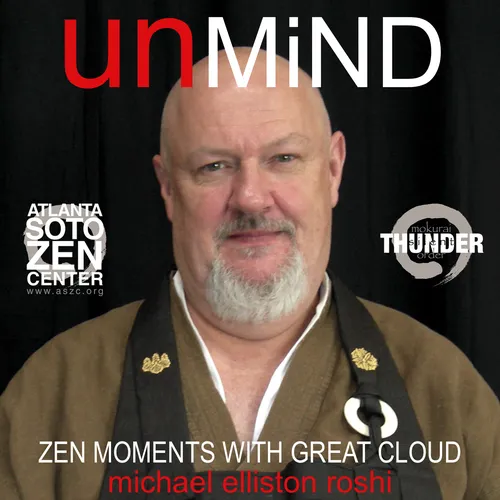
UnMind: Zen Moments With Great Cloud
A podcast of original teachings and music by Zenkai Taiun Michael Elliston Roshi, guiding teacher of the Atlanta Soto Zen Center and abbot of the Silent Thunder Order.
- Update frequency
- every 8 days
- Average duration
- 16 minutes
- Episodes
- 99
- Years Active
- 2022 - 2025

96. People, God & Design Intent
Whose idea was this?
It certainly wasn’t mine —
Perhaps it is yours?
* * *
The thread running through this series is the underlying connection, the various links, between Design thinking and Zen, and how…

95. Design Thinking & Zen Sitting
How to think Design?
Nothing is sep’rate in it —
Nothing excluded!
* * *
During the two years of the Covid-19 pandemic, like most other people I gained some wait and lost some of my vim and vigor. This i…

94. Designing a Zen Worldview
How to design Zen?
No need to redesign it —
It is already!
* * *
In this segment we will continue to explore the underlying or implied question of Buddhism: What is your worldview, exactly and in detail?…

93. Bucky, Me & Zen
Perfectly nat’ral,
A sitting tetrahedron —
Equilibrium!
* * *
We will continue our discussion of the influence of Design thinking on worldview, returning to one of my most influential mentors. I want to …

92. Design Intent, Comedy & Tragedy
It is laugh or cry —
the tragedy of humans
in hormonal rage.
* * *
This is one I did not want to have to write. But owing to the resurgence of mass shootings — emerging to fill the gap, now that the COVI…

91. Geodesics & Zen
Falling through a curve —
Sum total of all forces…
Zen’s “total function”!
* * *
In this segment we will return our attention back to the more personal sphere of meditation practice. Beyond any considera…

90. Politics & Design
Such a lovely world —
if it weren’t for the people!
Let’s get rid of them.
* * *
In the last segment on Precepts & Putin, I finally got around to asking what all these ethical and political issues have t…

89. Precepts & Putin
Dharma trumps karma
but it is not an escape —
Consequences come
* * *
Last Sunday we performed an initiation ceremony called “Jukai Tokudo” in Japanese. We had an international visitor and a couple of ot…

88. Zen Priest & Householder
Who is this Zen for?
Yes, you can practice alone —
sangha will survive.
* * *
No, this is not the beginning of a bad joke about a priest and a householder entering a bar. Though that certainly has happen…

87. Pandemic & 4 Spheres
The Four Spheres are real —
as real as anything else —
but temporary
* * *
We left off with the promise that we would continue examining the can of worms called “anxiety.” To a fish or a bird, as Master …

86. Anxiety & Completion
I may not be done —
my race may be almost run —
not yet... not yet... not...
* * *
In the discussion devoted to Bodhidharma’s four observations in zazen, we mentioned anxiety and serenity as one of the p…

85. 4 Spheres & Zazen
It’s all personal —
but entangled seamlessly
with universal
* * *
This is the last of a quartet of essays on semantic modeling, an approach that emphasizes simultaneity of components in a system and how …

84. Tetrad & Zazen
He was the great sage
who said no need for zazen —
if you grasp the truth
* * *
At the beginning of the last section on analysis and systems modeling, I suggested it may be worthwhile to delve a bit more…

83. Tetrad & Zen
It’s not that simple.
But it helps to simplify —
at least in your mind.
* * *
Before leaving the discussion of systems and analysis modeling, and its application to daily life and Zen practice, it may be…

82. Systems & Analysis
What is a system?
It has inside and outside —
all dharma beings.
* * *
We ended the last section with the suggestion that you consider the design of your Zen practice from a creative perspective, rather …

81. Discovery & Invention
Discovery now.
Invention follows later —
in Design or Zen.
* * *
One more point about process in general may be worth noting before considering the processes of discovery and invention in particular. Lik…

80. Processes & Outcomes
Process is the thing —
Outcomes only the result —
Some tweaking required
* * *
Matsuoka Roshi’s expression that “You have to work your way through every bone in your body” implies a kind of thoroughgoing…

79. Methods & Routines
Method and routine
may be hard to separate —
Work it out in time
* * *
In the last episode of our series on Design thinking and Zen, considering methods and materials, tools and techniques associated wit…

78. Methods & Materials
No matter the tool —
Whatever materials —
The method is Zen
* * *
In the last episode we ended by noting that the design of the method of Zen, as well as the equipment used in practicing it, were operati…